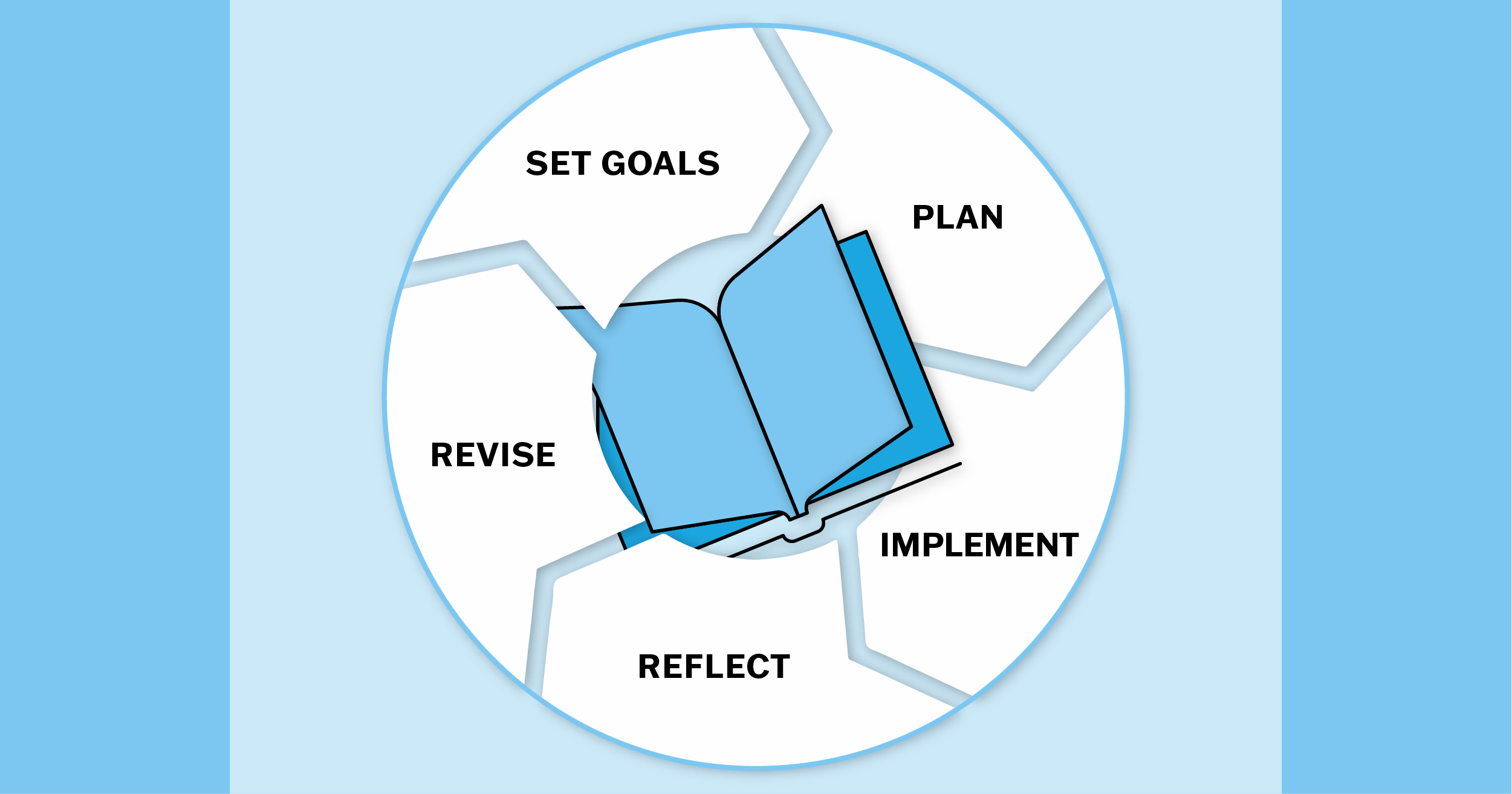Posted in: Aha! Blog > Wit & Wisdom Blog > Assessments Literacy Scaffolding Professional Development Implementation Support > Setting Goals and Planning for Next Year’s Wit & Wisdom® Implementation
THIS MONTH’S FOCUS
In last month’s issue, we discussed the cycle Wit & Wisdom educators can follow to strengthen their Wit & Wisdom implementation: (1) set goals, (2) plan for how to meet those goals, including how to gather evidence and feedback on progress, (3) implement the curriculum, (4) reflect on implementation, and (5) revise or write new goals based on evidence and reflection (and repeat the cycle).
-png.png?width=500&name=goals-and-planning-for-W%26W-44%20(1)-png.png)
Last month, we tackled the reflection step of this process. This month, we turn our attention to setting goals and planning for how to meet them.
Although at year’s end, it is tempting to close our computers or classroom doors, walk away, and wait to set goals and make plans until back-to-school time, the end of the year is an ideal time to reflect and plan. Implementation is fresh in your mind. The concrete thinking needed for successful planning is easier now than later. In addition, the beginning of the school year is busy, so the thoughtful work of goal setting and planning is a challenge. Reflect and plan now, and you can relax this summer and start fresh in a few months. Finally, you may want to engage in professional learning around your goal(s), and summer is a great time to do that!
STEPS FOR GOAL SETTING AND PLANNING
The goals you set are personal to your strengths, challenges, and classroom context. Actions such as the following can be useful, though, for all Wit & Wisdom teachers, no matter the specific situation and context. As you read on, you will see some examples of how fictional Wit & Wisdom teachers approach this process. Use these examples to clarify the elements of each action and to reflect, identify goal(s), and plan next steps.
Consider taking these actions now:
Action 1: Identify goals based on your end-of-year reflections. Take a close look at your end-of-year reflections. Which enhancements or changes in your practice could have the most impact on student learning? Use this thought process to identify your goal(s).
This table shows examples of how Wit & Wisdom teachers might translate their reflections into specific goals.
|
Teacher |
Teacher Reflection |
Goal |
|
1 |
Pacing: Although I improved over the year, I often took two or three days to complete a lesson. As a result, I did not teach Module 4.
|
Prepare and teach lessons with more attention to pacing, ultimately completing 80 percent of lessons in the recommended timeframe. |
|
2 |
Content Stages/Productive Struggle: |
Let students do more of the thinking and work that the Content Stages require so that students build knowledge, deepen understanding, and learn the independent, transferable skills they need to analyze complex texts. |
|
3 |
Writing: I feel most comfortable teaching informative writing, and my students did their best work with this writing type. I found the ToSEEC writing model helpful, taught Examine lessons effectively, and did well supporting students during Experiment lessons. I felt less comfortable with and less successful teaching opinion/argument writing. |
Develop greater knowledge and confidence in teaching students to write opinions/arguments, and hone instructional skills so that students become more effective with opinion/argument writing. |
Make goals realistic and attainable. When we choose lofty, extensive goals without achievable objectives, we often lose motivation and momentum. Looking at next year through rose-colored glasses is tempting, but try to ground yourself in the reality of a school year: Choose a goal or goals you can reasonably accomplish even with the busyness and bumps that the school year will inevitably bring.
In addition, strive for measurable goals. Consider what evidence you will gather to monitor progress and what benchmarks you will use to assess impact. As you do so, take an expansive view of measurable:
"[Some] goals do not lend themselves to quantitative measures, and that’s OK. Simply asking teachers how they determine whether they’ve progressed toward a goal can be a growth opportunity. If we want to be sure that our teachers see their students as more than percentiles, we need to give them the opportunity to reflect on and present their own growth in qualitative ways." (Hoerr, 2009)
Instead of thinking only about student data and other quantifiable results, think in terms of concreteness. How can you articulate what success will look like? How will you be able to see, hear, or document progress in some way? The main focus is how you will know and demonstrate success in meeting your goal, not having a number to show that success.
Let’s look at how the three teachers above could measure progress with their goals.
|
Teacher |
Goal |
Options for |
|
1 |
Prepare and teach lessons with more attention to pacing, ultimately completing 80 percent of lessons in the recommended timeframe. |
|
|
2 |
Let students do more of the thinking and work that the Content Stages require so that students build knowledge, deepen understanding, and learn the independent, transferable skills they need to analyze complex texts. |
|
|
3 |
Develop greater knowledge and confidence in teaching students to write opinions/arguments, and hone instructional skills so that students become more effective with opinion/argument writing. |
|
Action 2: Plan for professional learning. Summer is a great time to engage in professional learning. Make the most of that time by targeting professional learning to the goals you have set.
- Explore curricular resources. See a list of suggested resources below, including Wit & Wisdom’s Implementation Guide, Moving Forward with Wit & Wisdom, and module appendices.
- Attend Great Minds® professional development sessions. For a complete list of offerings, visit the greatminds.org professional development page.
- Read external research or expert guidance. Consider either individual study or a book club approach in which you and a group of colleagues with similar goals read and discuss identified resources. To find books, articles, or blog posts related to Wit & Wisdom goals, consult the Implementation Guide and the Aha! Blog.
- Observe colleagues or exemplar instruction. Watching a colleague in action can spur professional learning, especially when observing through a particular lens or with a series of guiding questions. If you have access to the Wit & Wisdom in Sync® videos, these can be a great source for analyzing Wit & Wisdom instruction in action.
- Engage with colleagues in deliberate practice. Use the professional learning method in which teachers practice delivering curricular content or facilitating curricular discussions with colleagues in the role of students. The chance to practice skills without the pressures of being in the classroom can be a powerful tool for improving teacher practice.
Because we are more likely to follow through with actions we organize and commit to writing, write out your plan for professional learning.
See this example of professional learning planning for Teacher 3:
|
Teacher 3 Goal: Develop greater knowledge and confidence in teaching students to write opinions/arguments, and hone instructional skills so that students become more effective with opinion/argument writing. |
|
Teacher 3 Professional Learning Plan |
|
Action 3: Plan for implementation. Once you have a vision of success, plan for lesson implementation. Slow down to consider specific teacher moves and student actions.
Consider questions like these:
- How will you prepare differently?
- What specific new moves will you incorporate into your lesson-level instructional routines and strategies?
- How will you analyze student work more intentionally?
- What feedback might support students more effectively?
Here is an example of Teacher 3’s planning:
|
Goal: Develop greater knowledge and confidence in teaching students to write opinions/arguments, and hone instructional skills so that students become more effective with opinion/argument writing. |
|
Goal Implementation Plan |
|
Lesson Preparation
Lesson Implementation
Lesson Follow-Up
|
Action 4: Plan for gathering evidence and feedback on progress. To ensure that your goal has its intended impact and that you can monitor progress, plan at the outset (1) what kind of evidence and information you will collect and (2) how often you will do so. Consider these common types of evidence:
- Artifacts (e.g., completed planning protocols, annotated lessons)
- Videos of instruction
- Notes from a colleague’s observations
- Student work samples
- Tallies of specific teacher moves or accomplishments
Here is an example of Teacher 3’s plan for evidence collection:
|
Goal: Develop greater knowledge and confidence in teaching students to write opinions/arguments, and hone instructional skills so that students become more effective with opinion/argument writing. |
|
Evidence to Collect |
|
Action 5: Plan for reflection and analysis. Finally, consider how and when you will analyze evidence. This step helps ensure that you follow through with your goal.
Plan for exactly what you will do with the evidence: Will you compare two different sets of evidence? Will you calculate percentages? Will you need to do qualitative analysis? Also, plan for when you will analyze evidence. Strive to do so at least twice during the period of your goal so that you can make needed adjustments.
Teacher 3’s plan for evidence analysis might look like this:
|
Goal: Develop greater knowledge and confidence in teaching students to write opinions/arguments, and hone instructional skills so that students become more effective with opinion/argument writing. |
|
Plan for Reflection and Analysis |
|
End of Summer
Mid-Module
End of Module
|
TIPS FOR EFFECTIVE REFLECTION
- Be flexible. Sometimes even the most carefully laid goals and plans turn out not to be appropriate or feasible given the context of the year or a new class. Or you may realize that you have different or additional ideas for how to meet a goal once you know more about the context and your students. While it is important to stick to your goals and plans, be flexible, adapting as needed to fit the situation and your new class. Continue to document changes to your plan to maintain a clear roadmap.
- Collaborate with colleagues. You are more likely to stick to your goals and carry out plans if you work with colleagues and support each other. Share ideas and resources, observe or consult on lesson performance, or collaboratively evaluate student work samples. Hold each other accountable for what you set out to do. Set up a schedule of check-ins, devoting time at meetings, texting, or emailing to report progress.
- Take advantage of technology. This past year, many of us have developed increased comfort with technology. Use this newfound comfort to support progress toward your goals. For example, videotape lessons to analyze later, have students use collaborative tools, or use simple data management programs to track student progress.
- Look for cross-curricular opportunities. Reap even more benefits from goal setting by implementing goals across subject areas. While some goals will be specific to Wit & Wisdom, others, such as those involving pedagogy, can improve your practice across disciplines.
- Celebrate incremental successes. Take the time to pause and celebrate when you and your class make significant progress. Doing so will motivate you to persevere.
CONCLUSION
Setting and working toward well-articulated, sound goals is essential to professional growth and improved student achievement. Take the time now to stop and articulate goals for next year and make a concrete plan to do so. Having a solid vision of success in place with clear benchmarks helps ensure you will accomplish what you set out to do. Your back-to-school self will be so appreciative!
After you set goals and make plans, take time to rest and restore yourself this summer. You and your students have been through quite a journey and deserve time to recover from it.
RESOURCES ON GOAL SETTING
Davis, Vicki. “Habits of Mind for the New Year: 10 Steps to Actually Accomplish Your Resolutions.” Edutopia.
Hoerr, Thomas R. “Principal Connection / Goals That Matter.” Educational Leadership, vol. 72, no. 1, 2009.
Rambo, Ernie. “Back to School, Back to Learning: How Teachers Can Set Their Own Professional Learning Goals.” Education Week.
Short, Jim, and Stephanie Hirsh. The Elements: Transforming Teaching through Curriculum-Based Professional Learning. Carnegie Corporation of New York, 2020.
RESOURCES FOR WIT & WISDOM
These Great Minds resources may support you in setting, planning, and implementing goals.
- Wit & Wisdom Teacher Edition Appendices
- Appendix A: Text Complexity
- Appendix B: Vocabulary
- Appendix C: Answer Keys, Rubrics, and Sample Responses
- Appendix D: Volume of Reading
- Implementation Guide
- Melissa and Lori Love Literacy
- Moving Forward with Wit & Wisdom
- The Wit & Wisdom Preparation Protocols
- Aha! Blog
- Wit & Wisdom in Sync Great Minds teacher videos
- Great Minds Digital Help Center
Submit the Form to Print

Lori Sappington
Lori Sappington is a Regional Director for Implementation Success at Great Minds®, where she strategically supports districts implementing Wit & Wisdom®. Before joining Great Minds, Lori was a literacy coach in Baltimore City Public Schools. Lori cohosts the literacy podcast Melissa and Lori Love Literacy, where she interviews teachers, leaders, and experts on their high-quality instructional materials journey.
Topics: Assessments Literacy Scaffolding Professional Development Implementation Support










